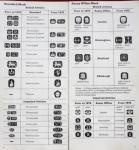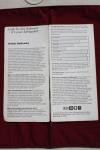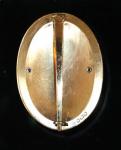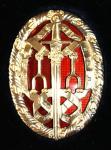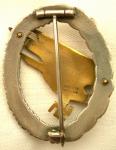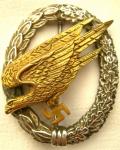-
Posts
13,225 -
Joined
-
Last visited
-
Days Won
22
Content Type
Profiles
Forums
Blogs
Gallery
Events
Store
Everything posted by Mervyn Mitton
-
One of the most important things for a collector is information. I have realised over the years that the British system of Hallmarking silver and gold is a mystery to many people - and to find a listing that clearly shows them is not always an easy task. The British system - at a glance , can tell you the maker - where it was assayed (usually where it was made) - the standard of silver - and the year it was assayed. All of the info. is on the following sheets - which were published by the Assay Offices in U.K. - their addresses are on the last page if you wish to order a copy. They also give gold marks - which are standardised for Europe. Next time you are browsing the markets have these sheets and a small magnifying glass and you will be surprised how often British silver turns-up - often in the unlikeliest places. (For those interested, I have just listed British Orders of Knighthood - in their correct precedence. This is under British Medals - Order of Knighthood.) Two important points to remember with silver - British standard, known as 'Sterling' - shown by the Lion Passant - is 925 parts silver, with 75 parts tin. This strengthens the silver. European silver is usually only a standard of 800 parts. However, where they are making for the English or American market , they will use 925 - but, with no hallmarks, they have to stamp it 'sterling'. American silver also uses the word 'sterling'
-
'JR' - probably Joseph Ridge of Sheffield - a well known maker. However, I'm surprised it wasn't one of the London firms - I suppose they 'farmed' the contract out. I am going to list the different Knighthoods - in their Order of Precedence. Initials that go after the name , are also shown. THE VC AND THE GC TAKE PRECEDENCE OVER ALL OF THESE. ORDER OF THE GARTER - KG ORDER OF THE THISTLE - KT ORDER OF THE BATH - GCB - KNIGHT GRAND CROSS ; KCB - KNIGHT COMMANDER ORDER OF ST.MICHAEL & ST.GEORGE - GCMG- KNIGHT GRAND CROSS ; KCMG- KNIGHT COMMANDER ROYAL VICTORIAN ORDER - GCVO- KNIGHT GRAND CROSS ; KCVO- KNIGHT COMMANDER ORDER OF THE BRITISH EMPIRE - GBE - KNIGHT GRAND CROSS BARONET'S BADGE - Bart. KNIGHT BACHELOR - Kt - (ON OCCASION) There are several other Orders - some have been dis-continued - others are for the Royal Family. These are the ones usually mentioned. I am going to start a new post - on the Lounge - showing the more usual Silver and Gold hallmarks. (I expect everyone has heard the standard jokes associated with the Order of St.M & St.G. ? Because it used to be given mainly to Civil servants,it was common for the initials to have a meaning. MBE - my bloody effort. OBE - Other B.....s efforts. KCVO - kindly call me God. GCMG - God calls me God. )
-
Doc - parcel has been ready for despatch since Monday - unfortunately the SA post office is not. They're on strike.. Will let you know when we can send. Included a WW1 1915 Star to a canadian - hope you can use it. Mervyn
-

Group Of WWII Flight Wings
Mervyn Mitton replied to Mike Huxley's topic in Great Britain: Research, Documentation & History
Every collector I know has this 'guilt' feeling. When I started collecting Police items every purchase was a 'soul searching' exercise - I've spent the money set aside for rates etc. many times to make sure I got something good. My advice to collectors now, is buy - good pieces are getting harder to find every year, and money makes itself back-up - eventually. Pity about letting the box slip away - who knows what else was in the box and if it was one of the market table dealers who bought, then it's doubtful if they will be recognised. -
Hi - Hugh. Your Insignia is dated for 1933 - which is the 2nd. pattern. The red enamel lacke the pattern on the earlier version and - strangely - there looks like more hallmarks on the reverse, upper right. Silver - if it is in two parts, is normally marked with the full set of hallmarks on the main part - and just a partial set on the other piece,or pieces. This makes it strange to show both marks on the same back - perhaps you could take a close-up. Have a look at the one I illustrate and you will see on the front - bottom left on the belt - the marks I mean. Not very visible, on either side of the sword point, are the initials for the artist who made the design. Yours does not have either of these. With your set of hallmarks, the meanings are as follows - Initials : the maker. Lion Passant: - signifies Sterling quality silver. That is 925 parts of silver per thousand - the other 75 parts being tin to strengthen the silver. The mark was established by the Goldsmiths and Silversmiths Guild in the 12th.Century. The Leopards Head : - this is the assay mint mark for London. (Birmingham is an anchor, Sheffield a Crown etc..) Without a hallmark - which the maker has to pay for - you cannot legally call an item - silver. Date Mark: - is the S with diagonal bars. This is the year letter for 1933. When combined with the assay mark you can say with certainty that it is 925 Sterling silver, you know where it was assayed (usually where it was made) and the year date. No other Country has such exact marking of silver - and the Common Market have been trying to get us to drop the system. Have just seen that you say the top letters are A9 - that will be the makers pattern number for that award. (Probably) I will post a full set of marks for the different assay offices - valuable ref.. Please remember that we specialise in silver in the shop and I will always be pleased to help. The Govt. - through the Queen - often confer a Knighthood on distinguished overseas people, who they wish to honour. They are Knighted with the sword and receive the regalia - this is always done with the approval of the persons Govt.. They are not allowed to use the title of 'Sir' - but many do - not illegal, just bad manners. Members of Commonwealth Countries, e.g. Canada, Aust., N.Z., use the title in the usual way. The sword the Queen uses belonged to King George 6th. - Her father. Megan - how strange that they can't wear the ribbon in uniform - I never understand all these weird rules - who decides these things...
-
One of the oldest types of Knighthood , King Henry 3rd. created Knight Bachelors in the 11th. century. He reigned from 1207 to 1272. This was the period that knights - who had to be Gentlemen - fought on horseback and most European Countries created them. The lowest Gentleman was an Esquire - and had to own a given area of land. As boys they were 'apprenticed' to knights to learn how to be a gentleman and how to handle weapons - they became known as Squires. Knight Bachelors may be the oldest, but they rank lower then the Orders of Knighthood - e.g. Garter; Thistle; Bath, etc.. They do not have the status of the Orders and do not have the initials of the order after their name. On occasions when they need to show they have a knighthood, they can use Kt.. Most of them in modern days are politicians or, ex chairmen of the gas board... Until 1926 there was no insignia for them to wear - however, there is an Association of Knight Bachelors and they petitioned King George 5th. , who in 1926 had a badge created for them to wear on formal occasions. There have been three versions over the years - but, the one shown here is hallmarked for London 1926 , and is therefore, in that rare first group issued. Made of silver, the centre is of red enamel and all of the gold parts are gilt. The badge shows a cross hilted sword, suspended from a belt. (Hence the expression - a belted knight or, a belted Earl ) On either side are spurs - with the rowels at the top. These of course represented the accroutrements of a Knight 700 years ago and , it was death to wear them if you were not entitled. I have looked back through the index and can find no ref. to Knights' Badges - over the years there must have been others ? I hope others can add to this post - Knighthood,as in Chivalry - is a wonderful subject.
-
I believe this to be a genuine Luftwaffe parachutists passing out badge - hopefully, our Forum experts will be able to confirm this - or, tell me otherwise ? The badge is 5 cm. top to bottom. 4 cm. from side to side. Weight is exactly 40 gms. The name on the reverse - above the Swastika is : W.DEUMER SUDENSCHEID. I have close-ups of the pin and hook, since I know these can be problem areas. Any help will be much appreciated - also, any indication to value - not my field.
-

Group Of WWII Flight Wings
Mervyn Mitton replied to Mike Huxley's topic in Great Britain: Research, Documentation & History
The three top wings are worth more than that - each ! -
The item shown in the centre of these interesting awards is the traditional Swazi Battle Axe. The shape is distinctive from other Southern Africa axes in that is is a triangle shape and set down the shaft. Zulus never made such good axes and the present Zulu King - Goodwill Zwelathini - carries a chromed one of these on formal occasions
-
Well done Rob - I bet that was the badge Tom remembers. The boomerang could easily look 'clear' if the lighting was wrong. All these great ref. books you keep showing - my bookshop in UK is going 'crazy' trying to find them. Should you ever find another copy of the Slouch hat one, I will very happily add your costs and postage. I often wonder how many Aussies belong to the Forum - I know that not enough of them are posting !! I wonder if the Chairman ever posts a breakdown by Country - mind you, he's probably getting over one after all the up-dates..... What could be our next Aust. topic ?
-

Zulu items
Mervyn Mitton replied to helen's topic in Great Britain: Militaria: Badges, Uniforms & Equipment
-

Zulu items
Mervyn Mitton replied to helen's topic in Great Britain: Militaria: Badges, Uniforms & Equipment





